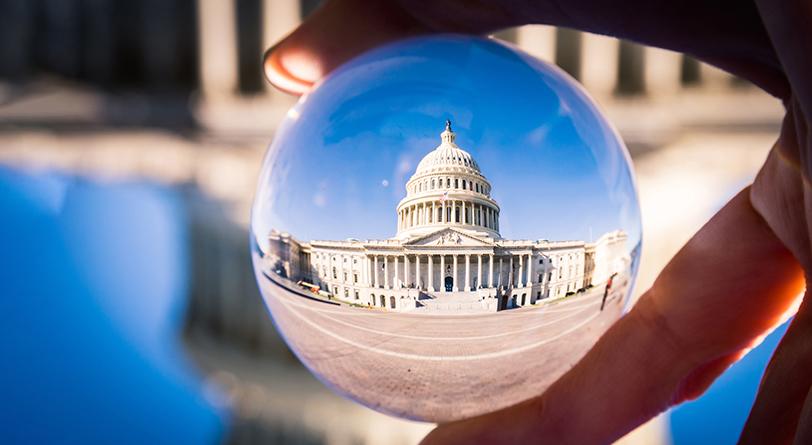With 2024 being an election year for the president and numerous members of Congress, conventional wisdom would suggest that the elected leaders might concentrate more on the horse races than public policies this year. However, significant legislation has been working its way through Washington, D.C., requiring constant monitoring of incremental developments.
“Although there will likely be less new federal legislation in play with 2024 being an election year, Consumer Brands will be working to ensure federal attention remains on improving the national recycling system,” says John Hewitt, vice president of packaging and sustainability at the Consumer Brands Association (CBA). “Regardless of the upcoming election year, Consumer Brands will be advocating for federal investment in recycling infrastructure and education, specifically through standardized recycling definitions and improved national recycling data collection.”
CBA, the Flexible Packaging Association (FPA), and AMERIPEN—the American Institute for Packaging and the Environment note they are paying particular attention to the Recycling Infrastructure and Accessibility Act of 2023 (RIAA) and the Recycling and Composting Accountability Act (RCAA). RIAA and RCAA had been introduced previously and passed the U.S. Senate but did not receive further consideration by the U.S. House, says Sam Schlaich, FPA’s former counsel for government affairs.
“There are several pieces of legislation at the federal level that we currently have our eyes on,” says Schlaich, adding that federal officials also will be preoccupied with high-profile domestic and world events this year. “However, just because some of our policy priorities might not receive a ton of attention in 2024, these issues aren’t going away, and the industry must maintain its outreach, education, and advocacy efforts at the federal level.”
RIAA and RCAA
RIAA would establish a pilot grant program to fund projects that will significantly improve accessibility to recycling systems through infrastructure investments, Schlaich says. RCAA, meanwhile, focuses on establishing data collection and reporting requirements concerning composting and recycling programs. FPA supports both measures, adds Alison Keane, FPA president and CEO.
AMERIPEN, which works closely with FPA and other packaging stakeholders, considers both bills “good, sound public policy,” says Dan Felton, AMERIPEN executive director.
And CBA has been directly engaged in supporting RIAA, which the trade group deems a bipartisan bill important to closing the gap in national recycling rates. Nationally, the consumer products industry continually invests in improving circularity for its products, while consumers must navigate varying rules among nearly 10,000 recycling jurisdictions, Hewitt says.
“Developing and updating recycling infrastructure to pursue circularity for packaging materials is a fundamental component of Consumer Brands’ agenda,” he says. “To reach true circularity, … there must be significant development to the nation’s recycling system.”
RIAA would implement a pilot recycling program for select communities without access to materials recovery facilities to increase recycling in those areas and address equity in recycling infrastructure, Hewitt says.
CBA also supports RCAA. “The bill makes a crucial investment in resources needed to develop the existing recycling system through its improvement of data collection on recycling and composting rates across the country,” Hewitt says. “RCAA was passed in the Senate by unanimous consent in the previous Congress, and Consumer Brands is hopeful the bill, which has since been reintroduced, will receive strong bipartisan support.”
Sustainability Goals and Targets
Long before this election cycle, companies had set sustainability targets for 2025, and both RIAA and RCAA could help further those goals.
“Consumer Brands believes the Recycling Infrastructure and Accessibility Act and the Recycling and Composting Accountability Act are complementary to the commitments our member companies have made to improving the sustainability of their products,” Hewitt says. “Many of our members have progressed significantly toward these industry goals by designing for recyclability, minimizing packaging, and increasing their use of recycled content.”
But with 2025 fast approaching, Keane says, she thinks some major companies will have to adjust goals to have all packaging recyclable next year.
“These are ambitions, and they will not come to fruition,” Keane says. “However, those companies and our members that support them will continue to strive for ultimate circularity in packaging—it just isn’t as easy as policymakers believe it should be.”
Staying Connected
CBA points out that thoughtful federal solutions are critical to meeting industry sustainability goals and achieving circularity for consumer products.
And FPA wants to ensure flexible packaging remains part of the discussions, Keane and others say.
Capitoline Consulting LLC, which advocates for FPA on a federal level, works to educate members of Congress and their staff members on the benefits and sustainability of plastic packaging, says Liz Roberts, Capitoline principal and co-founder. She says the dynamics in Washington could change dramatically this year. (Capitoline, which writes a column for FlexPack VOICE®, provides further insights into what to expect in Congress this year in the article titled “Congress Ponders Packaging Legislation.”)
“It is very possible that control of the House, Senate, and the White House could flip political parties, which would change legislative priorities in Congress,” Roberts says. “Additionally, with the significant number of retirements in both Chambers and both parties, the 119th Congress will look very different than the current one.”
Most of the legislative actions that caused concern for the flexible packaging industry in 2023 originated in the Democratic-led Senate, she says.
“A Republican in the White House would likely refocus federal priorities in support of business and manufacturing,” Roberts suggests.
Thomas A. Barstow is senior editor of FlexPack VOICE®.

SIDEBAR: Other Initiatives to Watch
Numerous other bills and measures could impact the packaging industry in 2024, according to AMERIPEN—the American Institute for Packaging and the Environment, the Consumer Brands Association (CBA), and Flexible Packaging Association (FPA).
- The Rewarding Efforts to Decrease Unrecycled Contaminants in Ecosystems (REDUCE) Act (Senate [S.] 2844/House of Representatives [H.R.] 5564) calls for an “onerous proposed virgin plastic resin tax,” says Dan Felton, executive director of AMERIPEN. The tax would be $0.10 per pound in 2024, up to $0.20 per pound in 2026. Alison Keane, FPA president and CEO, agrees the tax goes too far. “While the bill would use the money to fund infrastructure investments for plastics recycling, which FPA would support, FPA believes there are better ways to do this for all packaging so it does not support this bill as currently written,” she says.
- For the past several years, the National Defense Authorization Act included several provisions seeking to address issues arising from the use of per- and polyfluoroalkyl substances (PFAS), says Sam Schlaich, FPA’s former counsel for government affairs.
- PFAS are also part of the No Toxics in Food Packaging Act (H.R. 6105). Felton calls the legislation unique and “potentially onerous.” It declares five classes of substances as unsafe for food contact: ortho-phthalates; all PFAS; all bisphenols (A, B, S, F, or AF) and related compounds; styrene; and antimony trioxide, Felton says.
- Felton and Schlaich point to the Break Free From Plastic Pollution Act (S. 3127/H.R. 6053) that was recently reintroduced. Felton says it is “arguably broader and more aggressive than earlier session versions.” It includes extended producer responsibility (EPR) for packaging and beverage containers with scaling recycling rates, single-use plastic source reduction requirements, toxic substance requirements and restrictions, a single-use plastic bag ban, a polystyrene foam food service products ban, and a black plastic packaging ban. Schlaich says the bill also would set up a national deposit return system for beverage containers. “There is a lot to unpack in this bill—it’s over 200 pages long,” he says. Keane says the bill is concerning. “While it is a conversation piece and not expected to move, it has some troubling provisions, and FPA does not support it,” Keane says, noting the moratorium on new virgin plastic production.
- As far as bans on plastics, Keane says, “we continue to see the random and unwarranted plastic ban legislation, mostly at the state level. But we consider a moratorium on plastic production to be a ban—the Break Free From Plastics Pollution Act.” In Canada, a new federal regulation may ban the use of plastic packaging in certain applications, she adds. “While that consultation process is ongoing, so the outcome is uncertain, it is a challenge that we continue to have to defend against,” Keane says.
- Regarding the Save Our Seas Act 3.0, “we supported the two previous iterations and will hopefully be able to support some or all of 3.0,” Schlaich says.
- On the regulation front, the U.S. Federal Trade Commission will be updating the “Green Guides,” tools for businesses that provide clarity on how to communicate about environmental issues consumers care most about. Felton also points out that the U.S. Environmental Protection Agency (EPA) will continue its ongoing rollout of its National Recycling Strategy, and EPA will have its next steps with its “Draft National Strategy to Prevent Plastic Pollution.” “We will likely see more activity on all of these in 2024,” Felton says.
- Felton also says packaging companies should follow any federal legislation that seeks to harmonize/standardize federal definitions for compostable, recyclable, and reusable. Labeling requirements also should be monitored where efforts are being made to establish federal standards and requirements for packaging companies and brand owners that make on-packaging claims for compostability, recyclability, and reusability. “This is needed to avoid an emerging patchwork of state laws and requirements that could hobble the ability of product manufacturers to effectively label and sell their products within inter- state commerce,” Felton says.
- Schlaich says stakeholders should watch the federal “farm bill,” which sets funding and directs priorities for several federal food/agriculture consumption and production programs, including the Supplemental Nutrition Assistance Program. “It’s passed every five years, but this year, Congress was forced to extend the 2018 version by one year,” he says. “Due to its massive size, it is often a vehicle used to pass other policy initiatives and, therefore, worth keeping an eye on.”
- “We have also seen an uptick in legislation impacting the use of molecular—or advanced—recycling technology in recent years and expect this to be reflected in 2024 as well,” says John Hewitt, CBA’s vice president of packaging and sustainability. CBA “supports the use of molecular recycling technology as a complement to mechanical recycling for the recovery of quality recycled materials.”
- CBA, FPA, and AMERIPEN point out that significant packaging legislation continues to be debated at the state level. “While federal packaging legislation proposals may be less frequent in 2024, Consumer Brands anticipates a significant amount of action across state legislatures,” Hewitt says. “We will remain highly engaged in the states in pursuit of circular solutions for packaging.” So far, four states have passed EPR laws, and others are debating EPR this year. FPA monitors state legisla- tion with the help of Serlin Haley, a lobby- ing firm based in Washington, D.C. Serlin Haley also routinely provides a column for FlexPack VOICE®. (See “States Begin EPR Needs Assessments.”)
